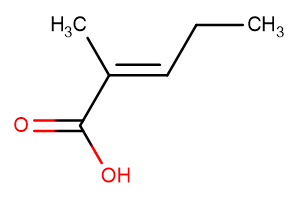
trans-2-Methyl-2-pentenoic Acid
CAS No. 16957-70-3
trans-2-Methyl-2-pentenoic Acid( (E)-2-Methyl-2-pentenoic acid )
Catalog No. M21395 CAS No. 16957-70-3
2-methyl-2-pentenoic acid also known as strawberry acid has a sweet berry-like aroma and flavor and is widely used in food flavor.
Purity : >98% (HPLC)
 COA
COA
 Datasheet
Datasheet
 HNMR
HNMR
 HPLC
HPLC
 MSDS
MSDS
 Handing Instructions
Handing Instructions
| Size | Price / USD | Stock | Quantity |
| 100MG | Get Quote | Get Quote |


|
| 200MG | Get Quote | Get Quote |


|
| 500MG | Get Quote | Get Quote |


|
| 1G | Get Quote | Get Quote |


|
Biological Information
-
Product Nametrans-2-Methyl-2-pentenoic Acid
-
NoteResearch use only, not for human use.
-
Brief Description2-methyl-2-pentenoic acid also known as strawberry acid has a sweet berry-like aroma and flavor and is widely used in food flavor.
-
Description2-methyl-2-pentenoic acid also known as strawberry acid has a sweet berry-like aroma and flavor and is widely used in food flavor.
-
In Vitro——
-
In Vivo——
-
Synonyms(E)-2-Methyl-2-pentenoic acid
-
PathwayOthers
-
TargetOther Targets
-
RecptorOthers
-
Research Area——
-
Indication——
Chemical Information
-
CAS Number16957-70-3
-
Formula Weight114.14
-
Molecular FormulaC6H10O2
-
Purity>98% (HPLC)
-
SolubilityIn Vitro:?DMSO : 100 mg/mL (876.12 mM)
-
SMILESCC/C=C(\C)/C(O)=O
-
Chemical Name——
Shipping & Storage Information
-
Storage(-20℃)
-
ShippingWith Ice Pack
-
Stability≥ 2 years
Reference
molnova catalog



related products
-
Wogonin
Wogonin is a naturally occurring mono-flavonoid, can inhibit the activity of CDK8 and Wnt, and exhibits anti-inflammatory and anti-tumor effects.
-
N-benzoyltyramine
The roots of Litsea hypophaea.
-
22'-Methylenebis(6-t...
22′-Methylenbis(4-methyl-6-tert-butylphenol) ist ein Antioxidans aus der Gruppe der Bisphenole.



 Cart
Cart
 sales@molnova.com
sales@molnova.com


